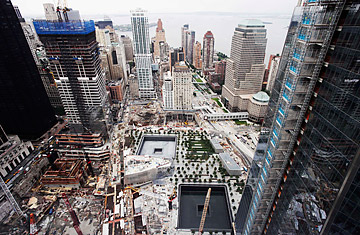
A view of the construction of the World Trade Center complex on Aug. 25, 2011
(2 of 3)
"It wasn't a normal project for me. This site isn't just a piece of real estate," says Libeskind. "I had to figure out a way to maintain a balance between the idea of memory and moving forward." His designs were heavy in symbolism: the 1,776-ft. structure was topped with off-center spire intended to mirror the Statue of Liberty's torch and aligned with the sun so that no shadow would be cast on the anniversary of the attacks.
At least, this was Libeskind's original idea; it's not what's actually being built. At the time of his hire, he had only a handful of completed buildings to his name, none of them very tall. "Dan was master planner, but he was not a high-rise specialist," says developer Silverstein, who had leased the original towers and was now in charge of rebuilding what was lost. Silverstein brought on another architect, David Childs, with whom he had worked before. He and Governor Pataki asked the two architects to work together.
Childs replaced Libeskind's torchlike spire with a more traditional antenna, and the sun alignment turned out not to be very feasible. The architects clashed publically for many years — "Architects like to work on their own," as Silverstein explains — but now take a benign, diplomatic tone in interviews. When asked about the changes to his design, Libeskind only says, "It's a challenge to bring a consensus to so many people with different interests."
Preliminary work on the tower began, symbolically, on July 4, 2004, but safety concerns and structural precautions necessitated major revisions. One critical problem was the issue of placement: a highway runs along the west side of Manhattan, and the Freedom Tower was set so close to it that the New York Police Department worried about security. "They couldn't be sure that a truck wouldn't come and blow it up," says Ward. The tower had to be completely redesigned; construction was delayed for another year. By the time work began in earnest, it was already 2006. At the time, officials said it would be finished in 2011. But in order for that to happen, Silverstein Properties, the real estate company owned by Larry Silverstein, had to come up with the money — much of which he hoped would come from insurance payouts on the original towers.
The New York real estate mogul had signed the lease on World Trade Center buildings just six weeks before 9/11 and spent the next five years locked in litigation with 22 insurance companies over what was at the time the biggest policy on a single piece of real estate. At issue was whether the towers' destruction counted as two different events, requiring two separate $3.5 billion insurance payouts, or just one. Ultimately, it came down to legal wording: for most of the companies, the towers were considered one event. Although Silverstein ultimately received more than $4 billion in payouts, he was still haggling with the insurance companies in court as late as 2007.
Things were moving slowly, and the 2008 financial crisis didn't help. (10 million sq. ft. of office space are tough when the economy is in a tailspin.) "At this point, five years had already elapsed and nothing was happening on the site," says Silverstein. "It became obvious that we had to get moving." To speed things along, Silverstein turned the Freedom Tower's construction over to the Port Authority in 2008. He is now in charge of only three buildings on the site: towers two, three and four. They are much smaller projects, between 72 and 88 stories tall, all scheduled to be completed between 2013 and '16.
The Freedom Tower got its name from a speech given by Pataki in 2003. It was a defiant stance for what would be the tallest building in a city that refused to be cowed by fear. But by 2009, the need for rhetoric had faded and Port Authority quietly renamed the project after its legal address: One World Trade Center. Local tabloids blasted the move as "unpatriotic," and Pataki complained about the use of the original north tower's address. The building's first lease went to a Chinese real estate company.
As construction work started and stalled and started up again, the LMDC and the Port Authority continued with another project: the 9/11 Memorial. Libeskind's original designs included a memorial, but it was stark and dispiriting, an 8-acre area dropped 70 ft. below street level. So in 2003 the LMDC held a second competition and selected Israeli-American architect Michael Arad's "Reflecting Absence" design from 5,201 entries. But instead of quick construction, Arad, Libeskind, the Port Authority and transportation-hub architect Santiago Calatrava found themselves tangled in a seemingly endless web of problems.
